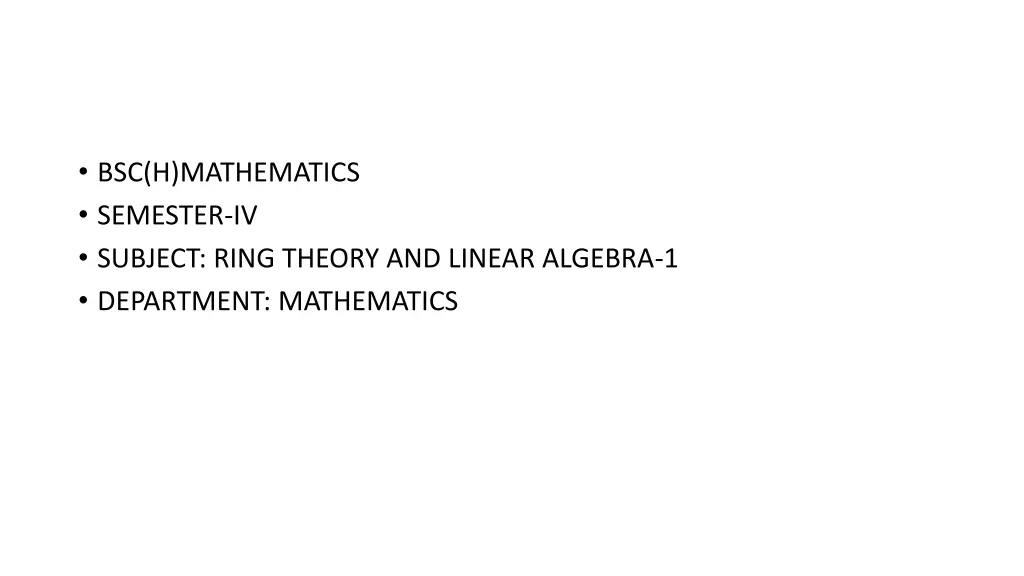
Ring Theory and Linear Algebra-1 in BSC(H) Mathematics Semester-IV
Explore the concepts of ideals and factor rings in ring theory alongside normal subgroups in group theory. Delve into the definitions, theorems, and applications, providing a solid foundation in abstract algebra.
Download Presentation

Please find below an Image/Link to download the presentation.
The content on the website is provided AS IS for your information and personal use only. It may not be sold, licensed, or shared on other websites without obtaining consent from the author. If you encounter any issues during the download, it is possible that the publisher has removed the file from their server.
You are allowed to download the files provided on this website for personal or commercial use, subject to the condition that they are used lawfully. All files are the property of their respective owners.
The content on the website is provided AS IS for your information and personal use only. It may not be sold, licensed, or shared on other websites without obtaining consent from the author.
E N D
Presentation Transcript
BSC(H)MATHEMATICS SEMESTER-IV SUBJECT: RING THEORY AND LINEAR ALGEBRA-1 DEPARTMENT: MATHEMATICS
CHAPTER-14 CREDIT: J. GALLIAN, 4THEDITION CONTEMPORARY ABSTRUCT ALGEBRA
Normal subgroups play a special role in group theorythey permit us to construct factor groups. In this chapter, we introduce the analogous concepts for rings ideals and factor rings.
Definition Ideal A subring A of a ring R is called a (two-sided) ideal of R if for every r [ R and every a [ A both ra and ar are in A. An ideal A of R is called a proper ideal of R if A is a proper subset of R.
Theorem 14.1 (Ideal Test) A nonempty subset A of a ring R is an ideal of R if 1. a - b A whenever a, b A. 2. ra and ar are in A whenever a A and r R.
Theorem 14.2 Existence of Factor Rings Let R be a ring and let A be a subring of R. The set of cosets {r + A | r R} is a ring under the operations (s + A) + (t + A) = s + t + A and (s + A)(t + A) = st + A if and only if A is an ideal of R.
let ? Where ? + ? + ? + ? = ? + ? + ? ? + ? ? + ? = ?? + ? To show : ? is an ideal. Given : ? is a sub ring of ?. For showing ? is ideal it is enough to show ??,?? ? where every ? ? ,? ?. ?= ? + ?: ? ?
Let ? ? , ? ? ? + ? = ? = ???? ??? ?& ? + ? ? ? ?? + ? = ? + ? (? + ?) = ???? ??? ? = ???? ??? ?= ? ?? + ? = ? ?? ? Similarly ?? ? ? is ideal of ? ? + ?
Converse : Let ? be the ideal of ?. To show : ? ?= ? + ? ? ? is a ring. Since ? is ring , ? ? ? Let ?1+ ? ,?2+ ? , ?3+ ? ? (i) ?1+ ? + ?2+ ? = ?1+ ?2 + ? ? (ii) ?1+ ? + ?2+ ? = ?1+ ?2 + ? ? ?( ?1+ ?2 ?) = ?2+ ?1 + A ( ?,+ ?? ????.) = ?2+ ? + ?1+ ?
(iii) ?1+ ? + ?2+ ? + ?3+ ? = ?1+ ?2 + ? + ?3+ ? ?1+ ?2 + ?3 + ? + ? ( ?,+ ?? ?????.) ?1+ ? + ( ?2+ ?3 + ?) ?1+ ? + ( ?2+ ? + ?3+ ? ) (iv) ?1+ ? + 0 + ? = ?1+ 0 + ? = ?1+ ? ||?? 0 + ? + ?1+ ? = ?1+ ? ( 0 is zero of ?) 0 + ? = ? is zero of ? ? = = ?1+ ?2+ ?3 = =
(?) since ?1 ? and ? is ring ?1 ? And ?1+ ? + ( ?1) + ? = 0 + ? = ? ( ?1) + ? is negative of ? ?1+ ? + ?2+ ? = ?1+ ?2 + ? ? ? ? (viii) Associative ( do yourself)
(viii) ?1+ ? = ?1?2+ ?3 + ? = ?1+ ?2+ ?1?3 + ?( ? ?? ???? ) = ?1+ ?2+ ? + ?1?3+ ? = ?1+ ? ( ?2+ ? + ?1+ ? + ( ?3+ ? (ix) Similarly ?2+ ? + ?3+ ? = ?1+ ? ?2+ ?3 + ? ?1+ ? ?3+ ? + ( ?1+ ? + ( ?2+ ? ) ? ?3+ ? ?3+ ? = ?2+ Hence R/A is a ring.
